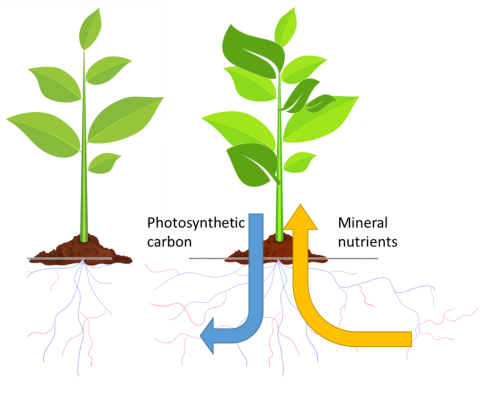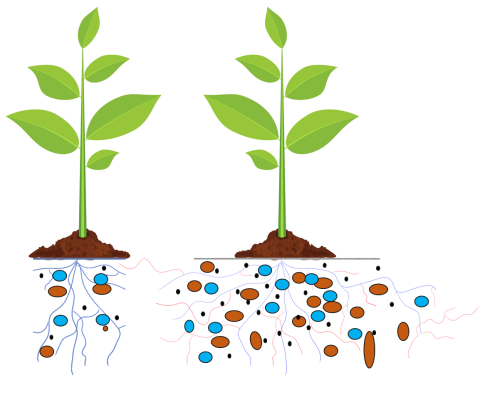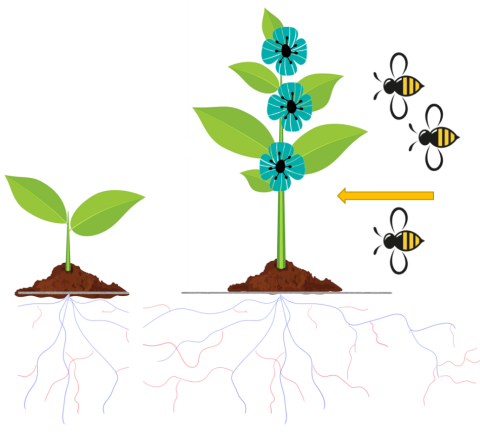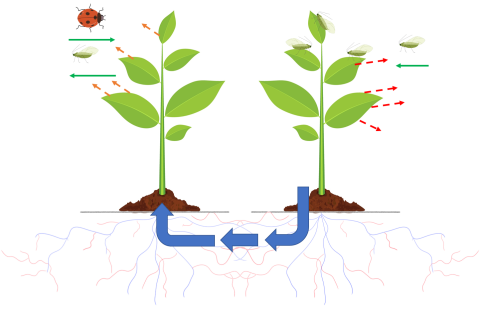22 August 2022
Dr David Cutress: IBERS, Aberystwyth University.
- Symbiotic fungi mycorrhiza have important interactions with many plant species
- Mycorrhiza, in optimal conditions, can improve plant growth with fewer inputs, improve soils and protect from weeds, insects, contamination and climate changes
- Mycorrhiza focused systems as such could act as a promising future tool to combat the increasing economic instability surrounding fertiliser costs in farming
- Optimising future systems should consider practices, and crops, which integrate well with mycorrhiza towards providing more environmentally sustainable production
Fungi, plants and soil
Most farming systems, whether they are crops, livestock or of a mixed focus are impacted by the soil health of the surrounding environment. Soil health is vital for the optimum growth of all species of plants including those involved in different pasture systems for direct grazing or silage production. The Knowledge Exchange Hub has previously produced several articles on the importance of soil health and practices which impact this, but one area that hasn’t been fully expanded is how important the interaction is between soil health and soil fungal species.
Soil fungal species which interact with plants are termed mycorrhiza and these are essentially universal across all soils, other than those which are severely degraded. These form relationships with around 80% of all terrestrial plant species. They evolved millions of years ago to interact symbiotically with plant species where they can act to essentially extend the root networks of a plant, enhancing the uptake of micro and macro-nutrients as well as water. Some species interact inside the plant root tissues themselves and are called arbuscular mycorrhizal fungi (AMF) whilst other species have an external interaction where they surround the roots (more common in woody plants) and are called ectomycorrhiza (EcM).
Whilst there are some noted interactions which can be considered detrimental to plants, the general consensus is that the abundance of mycorrhizae species are either neutral or beneficial in their interactions. Along with these largely beneficial effects on plants, the networks of hyphae (root-like structures of fungi), referred to as mycelia networks, play roles in improving soil health as these structures act to hold soil particles together (reducing erosion) as well as secreting protein-rich substances such as glomalin which can boost the soils organic matter content (SOM) and store nitrogen for up to 40 years. The mechanisms for some of these key beneficial activities are highlighted below along with visual representations.
Nutrient uptake
Adapted from Thirkell et al. (2017)
Root structures of plants are essentially improved and extended due to the symbiotic relationship with AMF/EcM systems as can be seen in the above and all following diagrams where plant roots (in blue) are extended via fungi hyphae structures (in red). This gives the plants access to a wider area from which they can take up nutrients and that the carbon produced by the plant can be distributed out into the soil. Above, a widespread mycelial network leads to extra leaf production and biomass in the plant on the right compared to the left.
One key nutrient with which mycorrhiza are associated with improving uptake is phosphorous (P). Whilst this is a complex situation dependent on the specific fungi and plant species, the root structures, and the available resources in the soil (naturally or due to fertiliser addition), generally, mycorrhizal interaction allows much better plant growth rates in P depleted soils and has been noted to play roles in nitrogen (N) uptake too.
Soil health
Adapted from Thirkell et al. (2017)
Soil health benefits due to the extensive root/hyphae structures allow for higher water retention (shown as blue dots) which is essential for plant growth and can boost survival in drought conditions and general stress tolerance. Also, when compared to plants without mycorrhizal relationships far more organic carbon (C) input and sequestration is present (black dots) whilst also better soil aggregation properties are achieved (brown shapes) which can play roles in the reduction of erosion amongst other things. Importantly these mycorrhizae act as an extremely rapid route for C transfer into the surrounding soils, with estimates that they account for 5 – 10% of the photosynthesised C in plant interactions.
Yield and growth benefits
Improved growth and yield impacts are suggested to be linked with fungal interactions in many situations as represented below. In these instances, the more extensive network of interaction leads to better growth. This can also impact the interactions with pollinating insects as healthier plants will have more energy available to produce more flowers and more nectar and in crops reliant on pollination for production this can be extremely important.
Plant competition and natural weed suppression are other areas where mycorrhizal symbiosis has roles with studies finding that weed growth could be reduced between 20-66%, essentially acting as a biological control strategy reducing the need for herbicides and ploughing. Mycorrhiza may also play a direct role in increasing food safety as they improve plant tolerance to organic contaminants, heavy metals and agrochemicals and act to concentrate these in the roots (and in some instances reduce their availability in soils) reducing the unsafe build-up in the aboveground human/animal edible components of plants.
Adapted from Thirkell et al. (2017)
Plant defence
Plant defence roles are also noted in literature through mycorrhizal interactions with plants causing the production of different volatile organic compounds (VOCs) to be released. This can be thought of as ‘signals’ to different herbivorous pest species to keep them away or potentially to encourage natural biological pest management, as signals that can encourage insect species that eat herbivorous species which would otherwise eat plant biomass, can also be released. In the figure below, you can see the movement (via green arrows) of groups of insects impacted by signalling from plants, boosted by mycorrhiza facilitating signal transfer between plants (blue arrows). More specifically EcM hyphae surround plant roots so they can add a layer of protection from pathogens physically and through their action to acidify the surrounding soils. Generally, these symbiotic relationships have also been shown to help plants be more stable to both biotic and abiotic stresses which are increasingly a risk in the changing environment due to climate impacts.
Adapted from Thirkell et al. (2017)
Finally, it is worth noting there is a significant level of complexity of interactions found with mycorrhiza and plant activities. For example, the lack of mycorrhiza can have strong negative impact on the competition between plant species as well as the establishment of seedlings to young plants along with a slightly less negative impact on overall plant diversity. Whilst AMF and EcM species have similar impacts on soils and plant competition they can act opposingly on plant establishment and plant diversity.
Practices that impact mycorrhizae
Many farm and land management strategies will impact mycorrhiza populations as they are integral within ecosystems. A breakdown of actions and impacts towards boosting symbiotic positive relationships are outlined in the following table and explained further in the section that follows.
|
Action |
Impact |
|
Consider if your production system’s crops are mycorrhizae dependent |
If they are mycorrhizal dependent consider the advice in this table. If not, it might be worth seeing if there are benefits to switching to more dependent crop species |
|
Increase plant diversity through species-rich grasses and mixed crop systems such as intercropping and polycultures |
Increased species of plants present increases the diversity of mycorrhizae which is linked with improved plant growth and productivity |
|
Reduce and optimise fertiliser levels considering targeting application based on accurate soil analysis |
Saves money and can lead to similar productivity as mycorrhizae work more efficiently if performed optimally |
|
Include root crops in rotations to reduce compaction issues |
Reduces anaerobic environments which would otherwise reduce the beneficial effects of mycorrhiza fungi |
|
Reduce soil compaction via optimised machinery and controlled traffic |
|
|
Use min or zero-till strategies |
Reduces disruption of root/hyphae networks maintaining soil carbon and aggregate structures of soils |
|
Use permanent or longer-term perennial rotation systems |
|
|
Avoid agrochemical use |
Aside from off-target environmental impacts, these can also be detrimental to mycorrhizae particularly as they can naturally perform the activity of insecticides and herbicides in many instances |
|
Consider more holistic environmental approaches such as organic, sustainable and regenerative farming systems |
These focus on maintaining soil health which benefits the total soil microbiome and ecosystems including fungal species and reducing chemical inputs with the benefits noted above |
|
Be persistent and patient |
For landscapes and soils where agricultural practices and amendments have been employed over a long time, the balances between plants, fungal networks and the total ecosystems may take time (decades) to recover fully |
Nutrient uptake
As noted there are suggested nutrient uptake benefits provided by mycorrhizal fungi, however, these are known to be impacted by the available soil nutrient levels. In situations where high fertiliser levels are applied to soils, this can make the interactions with mycorrhizae less efficient or potentially even negative in some cases. As such, there needs to be more consideration towards planning the levels of fertiliser applied to fields as getting this balance right could provide similar growth benefits to plants with lower quantities (and therefore costs) associated with organic or synthetic fertilisers.
Importantly, however, data suggests a significant amount of time is needed for soil conditions to recover following fertiliser addition and ploughing practices. In a study of farmed sloped areas in China it was found that it took between 12 and 32 years for species richness (of both plants and fungi) and soil carbon and nitrogen levels to equate to those found in natural unmanaged grasslands.
Furthermore, mycorrhiza tend to be obligate symbionts with a degree of host specificity, either to a group of plant species or in some instances singular plant species. As such in historic sites where particular crops have been grown over a long time, particularly monocultures, there may be a lack of available fungal species present (as these have had no hosts), meaning that attempts to change such systems to polyculture will take time for host fungal species to re-establish. This suggests that practices such as those present in organic (provided tillage is reduced) and regenerative farming systems should factor in well with improving mycorrhiza fungi networks and functionality.
Soil health
Practices that affect the structure of the root and hyphae networks are known to play roles in impacting the potential beneficial effects of mycorrhiza species. For example, tillage breaks up the soil and root structures and has been found to reduce the water-stable aggregates within soils as well as having roles in reducing SOM and decreasing the presence and diversity of fungi in soils. As such min and zero tillage strategies along with permanent or rotational perennial systems show considerable benefits in this area along with their suggested roles in climate mitigation strategies.
Yield and growth benefits
In pasture systems, one aspect that has been demonstrated to impact mycorrhizal levels is the level of species diversity present within a given grassland system. The higher the species richness of a grass system the more diverse the mycorrhizal population, and increasing the diversity of mycorrhizae has been linked with significant above-ground increases in biomass production. This has equally been presented from the perspective of crop diversity as well as grassland systems.
Plant defence
Whilst there are no specific examples of practices which act towards boosting the plant defence specific impacts of mycorrhiza, all of the elements discussed will improve fungal networks and health and therefore act to improve the plant defence aspects of mycorrhizal symbiosis.
Future considerations
Due to modern crops being dominated by varieties adapted to give higher growth and yield rates by utilising applied agrochemicals most efficiently, many of these crops (particularly cereals) have shown reduced interactions with mycorrhiza fungi. Looking to the future this may give added reasoning (aside from stress adaptation and nutritional benefits) to consider re-introducing more heritage crop varieties which will likely be less reluctant to form mycorrhizal interactions and perform better in lower input environmental focused farming practices. Similarly, there is debate surrounding the specific breeding of crops to waste less energy in developing extensive root systems. These plants would work beneficially with soils managed to preserve complex mycelial networks as the smaller roots would be offset by the nutrient gather and retention potential present within these networks. Essentially this could let plants focus more energy on above-ground biomass production.
There appears to be a complex level of interaction between mycorrhiza fungi and pesticides as well as other agrochemicals such as herbicides and insecticides. In some instances, these can be detrimental, neutral or even positive. As such, future research needs to determine how much these compounds factor into any upcoming strategies which might hope to bolster symbiotic fungal benefits.
Finally, there are already many commercially available “biofertilizers” inclusive of fungal inoculant species which attempt to boost the fungal biodiversity of soils through their artificial application. We will look to evaluate the function and effectiveness of these in a future article.
Summary
Mycorrhizae symbiosis within pasture and crop plants could play an important role in shifting agriculture towards environmentally-focused farming. Soils with established healthy mycelial networks are more adaptable to changing environments including droughts and floods which are more likely to occur due to climate change impacts. Also, they can play important roles in sequestering C long-term within soils and good maintenance of fungal networks will help to avoid losses of C due to factors such as soil erosion. As such, farming practices and systems should increasingly be considering our understanding of how activities can impact on mycorrhiza, towards improved holistic ecosystem functionality.
If you would like a PDF version of the article, please contact heledd.george@menterabusnes.co.uk




